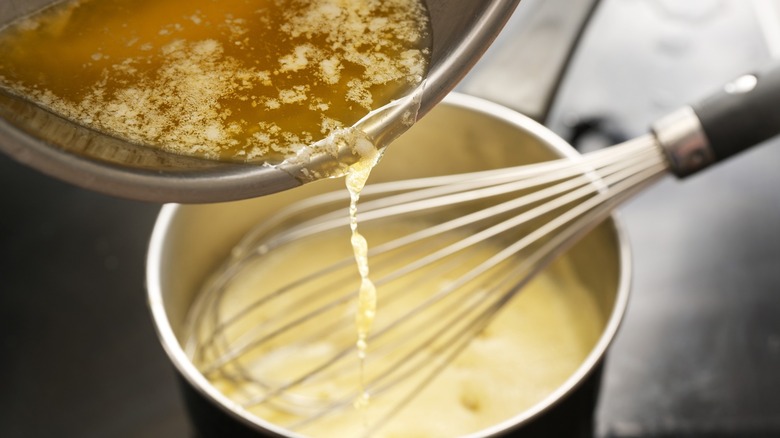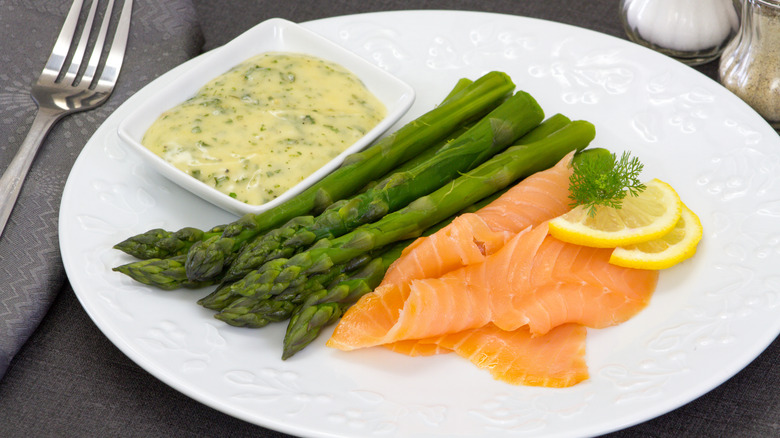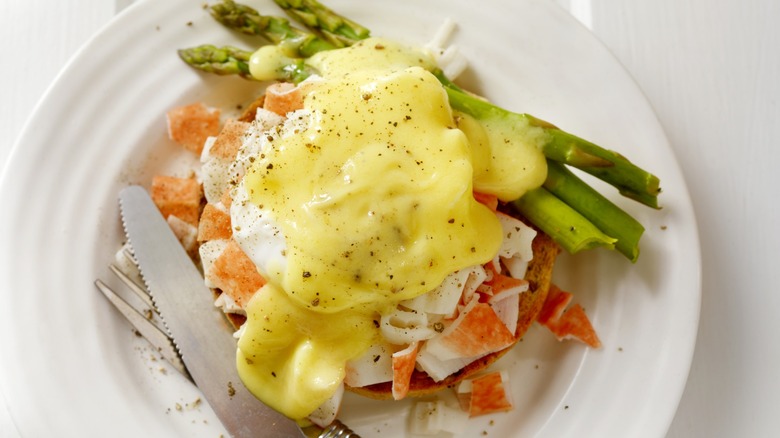The Difference Between A Hollandaise And A Béarnaise Sauce
If you're familiar at all with French cooking, or even if you just love a good eggs Benedict for a Sunday morning breakfast, then there's a good chance you're familiar with hollandaise sauce. And if you know hollandaise, then it's likely that you know its offspring, the decadent béarnaise sauce. Both of these sauces are very similar, with béarnaise sauce itself deriving from hollandaise about 200 years ago. Both sauces make use of butter, egg yolk, and some kind of acidic ingredient. So if they're so similar, how are they so different that they deserve completely different names?
Put simply, the ingredients added to (or modified in) béarnaise sauce make it completely distinct from its popular predecessor. While hollandaise sauce makes use of a few simple and readily available ingredients and is rightly renowned for this, béarnaise sauce adds complexity to its core ingredient as well as its supplementary ones.
Firstly, béarnaise subs out the lemon juice found in hollandaise for a more nuanced white wine vinegar. Secondly, béarnaise sauce makes use of ingredients that simply aren't found in hollandaise such as shallots, tarragon, and other various herbs, making it much more herbaceous while also thinning the texture somewhat. It's in these key differences that béarnaise separates itself from hollandaise.
Are these sauces interchangeable?
Though béarnaise and hollandaise are two different sauces, they share the same starting point and even have many of the same taste characteristics. These sauces have so much in common that you can, in theory, create béarnaise sauce out of leftover hollandaise sauce by reducing your hollandaise and adding in the extra ingredients required for a béarnaise. It's not exactly a one-for-one exchange, but it shows how similar these two sauces are and how béarnaise may have been developed from hollandaise from the start. This is certainly feasible given the timeline for each.
As one of the five famous French mother sauces, recipes for hollandaise sauce first appeared in documents in 1651, and though the name "hollandaise" literally means "from Holland," it's undoubtedly a French sauce. Its inclusion as one of the mother sauces only goes to show its importance in curating French cuisine. Béarnaise sauce, meanwhile, came significantly later, in 1836; and like hollandaise sauce before it, it doesn't originate from its namesake location. Rather, béarnaise sauce gets its name from French royalty –- a fitting name for such a rich condiment.
Finding uses for hollandaise and béarnaise
Since these two sauces represent one of the French mother sauces and its descendant, it can be assumed that hollandaise and béarnaise can be used in a multitude of delicious dishes. After all, the mother sauces are meant to represent the baseline or a "point A" of cooking. And wouldn't you know it, both of these sauces find multifarious purposes throughout the culinary world.
Hollandaise and béarnaise sauces are probably most often seen as the topping for eggs Benedict, which itself has an interesting past. But if you're not feeling the whole dish, or simply feel like skipping out on the carb component, hollandaise sauce is still a reliable option to elevate poached eggs no matter what time of day it is.
You'll do a disserve to these creamy sauces typecasting them with the brunch staple, as they both are excellent choices for dishes consisting of seafood such as salmon, turbot, or shellfish, and for vegetables like asparagus or broccoli. You can even use them as a dipping sauce for French fries if you'd like. Whether you choose the simpler hollandaise to add a creamy texture to these dishes, or if you want to add a herbal component to the mix with béarnaise, these sauces will add a dose of decadent magic to even the most humble of dinners.


